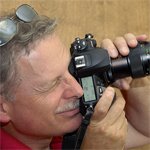Have you discovered the power of creating fully finished graphics in Photoshop CS? With the ability to incorporate all your image editing, special effects with basic layout tools, you have essentially infinite creative control in one application.
Here's a sample of an ad I did entirely in Photoshop CS2. Normally, I would normally create bitmaps and import them into Quark Xpress for layout, but to get this look, and save a ton of time and aggravation, I did the whole job in PS CS.
Here's a sample of an ad I did entirely in Photoshop CS2. Normally, I would normally create bitmaps and import them into Quark Xpress for layout, but to get this look, and save a ton of time and aggravation, I did the whole job in PS CS.
One-Stop - Photoshop!
Taking a stock photo, I applied a texture effect to separate it from the more real instrumentation rack. Then, I chopped out the middle for some white space to add the message and added the drop shadows. Determining the best the layout with all the various elements being visible is a real designer's joy. Editing and resizing is so easily done inside PS CS. Color experimentation was another convenience that is not easily done in switching programs and reimporting images, etc. Matching the colorization of the stock image to the text was a snap - another long step in Quark Xpress. And the fact that type is rendered as vector art in PS CS2 now is another big plus!

Web Design with PS CS
Another well known venue for PS documents is the web. Design consists of creating logos, art, text and supporting images into one document. Layout is accomplished with a series of common elements that appear on each page and content for each webpage. Individual webpage are composed by making approporiate layers visible and saving the composite image as a JPG image. The JPGs are then imported into Dreamweaver or other web editor and treated as typical HTML pages with image links for navigation - simple, flexible, consistent and fun!
The following two samples are websites I designed entirely within PS CS2:

Integrated Solutions

Mule
Taking a stock photo, I applied a texture effect to separate it from the more real instrumentation rack. Then, I chopped out the middle for some white space to add the message and added the drop shadows. Determining the best the layout with all the various elements being visible is a real designer's joy. Editing and resizing is so easily done inside PS CS. Color experimentation was another convenience that is not easily done in switching programs and reimporting images, etc. Matching the colorization of the stock image to the text was a snap - another long step in Quark Xpress. And the fact that type is rendered as vector art in PS CS2 now is another big plus!

Web Design with PS CS
Another well known venue for PS documents is the web. Design consists of creating logos, art, text and supporting images into one document. Layout is accomplished with a series of common elements that appear on each page and content for each webpage. Individual webpage are composed by making approporiate layers visible and saving the composite image as a JPG image. The JPGs are then imported into Dreamweaver or other web editor and treated as typical HTML pages with image links for navigation - simple, flexible, consistent and fun!
The following two samples are websites I designed entirely within PS CS2:

Integrated Solutions

Amberwood Custom Homes (still under construction)
In this site, we intend to include slide shows of custom home details and designs for selection and modification by customers.
The advantages of using PS CS is remarkable - every element can be created and manipulated in one document. Future edits and redesigns are easy, and output resolution can be maximized for print or web uses. Why would you use anything else?
In this site, we intend to include slide shows of custom home details and designs for selection and modification by customers.
The advantages of using PS CS is remarkable - every element can be created and manipulated in one document. Future edits and redesigns are easy, and output resolution can be maximized for print or web uses. Why would you use anything else?
Mule

















